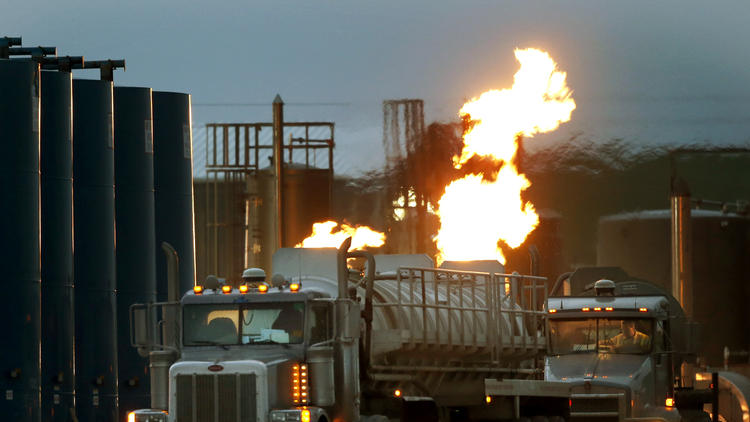
APphoto_APTOPIX Oil Boom Photo Gallery
Tanker trucks for hauling water and fracking fluids line up near a natural gas flare in Williston, N.D. Fracking has touched off a nationwide oil and gas boom, and with it, worries about public health and the environment.
Fracking has occurred in underground sources of drinking water in sources of water that could be used by people.
Energy companies are fracking for oil and gas at far shallower depths than widely believed, sometimes through underground sources of drinking water, according to research released Tuesday by Stanford University scientists.
Though researchers cautioned their study of hydraulic fracturing, or fracking, employed at two Wyoming geological formations showed no direct evidence of water-supply contamination, their work is certain to roil the public health debate over the risks of the controversial oil and gas production process.
Fracking involves high-pressure injection of millions of gallons of water mixed with sand and chemicals to crack geological formations and tap previously unreachable oil and gas reserves. Fracking fluids contain a host of chemicals, including known carcinogens
Fears about possible water contamination and air pollution have fed resistance in communities around the country, threatening to slow the oil and gas boom made possible by fracking.
Fracking into underground drinking water sources is not prohibited by the 2005 Energy Policy Act, which exempted the practice from key provisions of the Safe Drinking Water Act. But the industry has long held that it does not hydraulically fracture into underground sources of drinking water because oil and gas deposits sit far deeper than aquifers.
The study, however, found that energy companies used acid stimulation, a production method, and hydraulic fracturing in the Wind River and Fort Union geological formations that make up the Pavillion gas field and that contain both natural gas and sources of drinking water.
“Thousands of gallons of diesel fuel and millions of gallons of fluids containing numerous inorganic and organic additives were injected directly into these two formations during hundreds of stimulation events,” concluded Dominic DiGiulio and Robert Jackson of Stanford’s School of Earth Sciences in a presentation Tuesday at the American Chemical Society conference in San Francisco.
The scientists cautioned that their research, which is ongoing and has yet to be peer-reviewed, “does not say that drinking water has been contaminated by hydraulic fracturing.”
Rather, they point out that there is no way of knowing the effects of fracking into groundwater resources because regulators have not assessed the scope and impact of the activity.
“The extent and consequences of these activities are poorly documented, hindering assessments of potential resource damage and human exposure,” DiGiulio wrote.
Underground sources of drinking water, or USDWs, are a category of aquifers under the Safe Drinking Water Act that could provide water for human consumption.
“If the water isn’t being used now, it doesn’t mean it can’t be used in the future,” said DiGiulio, a Stanford research associate who recently retired from the Environmental Protection Agency. “That was the intent of identifying underground sources of drinking water: to safeguard them.”
The EPA documented in 2004 that fracking into drinking water sources had occurred when companies extracted natural gas from coal seams. But industry officials have long denied that the current oil and gas boom has resulted in fracking into drinking water sources because the hydrocarbon deposits are located in deeper geological formations.
“Thankfully, the formations where hydraulic fracturing actually is occurring…are isolated from USDWs by multiple layers and often billions of tons of impenetrable rock,” said Steve Everley, a spokesman for Energy in Depth, an industry group.
One reason this information is so important is because fracking is exempt from almost all provisions of the federal Clean Air, Clean Water, Safe Drinking Water, and Emergency Planning and Community Right to Know Acts.
DiGiulio and Jackson plotted the depths of fracked wells, as well as domestic drinking water wells in the Pavillion area. They found that companies used acid stimulation and hydraulic fracturing at depths of the deepest water wells near the Pavillion gas field, at 700 to 750 feet, far shallower than fracking was previously thought to occur in the area.
“It’s true that fracking often occurs miles below the surface,” said Jackson, professor of environment and energy at Stanford. “People don’t realize, though, that it’s sometimes happening less than a thousand feet underground in sources of drinking water.”
Companies say that fracking has never contaminated drinking water. The EPA launched three investigations over the last six years into possible drinking water contamination by oil and gas activity in Dimock, Pa.; Parker County, Texas; and Pavillion, Wyo. After initially finding evidence of contamination at the three sites, the EPA shelved the investigations amid allegations by environmentalists and local residents that the regulator succumbed to political pressure.
Jackson said the Stanford study’s findings underscore the need for better monitoring of fracking at shallower depths. “You can’t test the consequences of an activity if you don’t know how common it is,” he said. “We think that any fracking within a thousand feet of the surface should be more clearly documented and face greater scrutiny.”
The Stanford study focuses on Pavillion, in part because of DiGiulio’s familiarity with the area when he served as an EPA researcher in the latter stages of the Pavillion water study. Industry and the state of Wyoming questioned the EPA’s methodology after its 2011 draft report found the presence of chemicals associated with gas production in residents’ well water. In June 2013, the EPA turned over the study to Wyoming regulators, whose work is being funded by EnCana, the company accused of polluting the water in Pavillion.
The EPA study looked at whether chemicals migrated upward from fracked geological zones into people’s well water. The Stanford research does not explore the possibility of migration, focusing instead on the injection of fracking chemicals directly into geological formations that contain groundwater.
The EPA does not keep track of whether underground sources of drinking water have been hydraulically fractured as part of oil and gas development, said Alisha Johnson, a spokeswoman. “EPA does not maintain a database of all the wells being hydraulically fractured across the country,” she said in an email.
In their presentation, DiGiulio and Jackson noted that the EPA considers the Wind River formation and the Fort Union stratum below it to be underground sources of drinking water. The conventional image of tight geological formations where fracking occurs is that they are monolithic stretches of rock. But the scientists say the geology of the two formations is mostly sandstone of varying permeability and water.
“People think these formations are impermeable, and so they wonder, ‘Why are you worrying about water?’” DiGiulio said. “But it is an extremely heterogeneous environment, with areas of low and high permeability mixed together and with many lenses conducting water.”
Follow @neelaeast for energy and environmental news.
Copyright © 2014, Los Angeles Times
